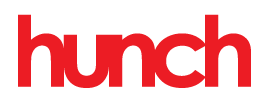How to get action from insights.
“This is the earliest I’ve ever been at Uni.” That’s how Kate Thomas opened an informative and thought-provoking breakfast on ‘turning insights into action’. Hosted by the Research of Association NZ, most of the coffee was poured by research agencies and their client counterparts. We decided to go because it sounded interesting. As creative and strategic type people, we rely on great insights to do great work. And learned heaps. So for those who didn’t make it, here’s an outsiders peek into the world of research.
Great insight. So what?
That was the core question from Kate Thomas. She leads Spark’s insights team whose role is to use insight to influence strategies that drive change. “Insights in themselves aren’t all that useful,” said Kate, “It’s only when you can use insight to drive action that good things happen”. It was the theme of the day and came up a lot.
Kate took us on a journey of how the insights team at Spark had a clear focus on projects that could deliver actions to build credibility and increase the profile of actionable insights. That’s led to bigger projects and better results. But Kate’s secret at Spark is focus. “You can’t do anything if you try to do everything,” said Kate. “It’s about doing less, but doing more with it.”
Next, Kate outlined three ingredients of a strong Insight team: context, relationships and communication. It’s important to be clear about who’s buying. What are their drivers? What are their KPIs? If you’re solving an active problem you’re more likely to deliver an actionable insight. The value of strong relationships and great communication are probably obvious, but Kate was quick to point out that relationships outside of the ‘core project’ were as valuable as specific stakeholders – and nobody uses Powerpoint anymore, right? These ingredients were backed up by three essential behaviours: collaboration, perseverance and knowing when to let go.
Walking a mile on the customer’s jetty.
Next up was Simon Curran from Shine. He spoke to Shine’s collaborative role in the research world and their process of investigation, ideation and implementation. But that’s about the last thing Simon said about process. He talked about how we can create value by better understanding people. Specifically, Simon mooted the idea that “Research is a misunderstood concept – where more time can be spent on process than progress.” Or in other words (with a rocking horse analogy) “momentum doesn’t equal movement.”
One example that I enjoyed was the new product development of a beer brand for boaties. They’d talked to boaties, they’d tweaked the recipe and they’d bottled up a brilliant brew they were confident that boaties would love. But it wasn’t until the product failed that they realised no-one puts bottles on a boat – they use cans. “Ten minutes at the wharf with the customer and we’d have clocked that one immediately” said Simon.
Simon also talked to the value of understanding “Privileged Assets” – described as key business features that drive the ability to deliver customer benefits. In other words, what’s the secret sauce that actually makes a difference? And how do you use it to deliver value to customers. Or, to paraphrase Simon, “it’s not so much the product, it’s the things that feed it”
And he picked up on the ‘faster horse’ conundrum – the divergence of what people say they want vs what they actually do. And the value of immersive customer observation in identifying gold. This led to the difference between insights of reflection (what past behaviour might infer about tomorrow) and insights of projection (what context and observation can tell us about the future). All good stuff.
Building Frameworks of Understanding.
Last up was Camryn Brown from EY who kicked off asking which was more useful, 100 facts to choose from, or no facts at all. Camryn’s point was that information isn’t useful by itself, but only really useful if people understand it. Context. He spoke of building frameworks of understanding within a business. That was a bit big for my morning brain, but I think he was underscoring the importance of everyone being on the same page. Which everyone in the room was “Insights can only be actionable in solving problems where everyone is agreed on exactly which problem needs solving next.” He described the ideal scenario as a “tidy organisational mind”.
My favourite quote from Camryn related to the importance of consultants asking deeper questions and probing for the real problem. “If someone is asking for the right thing, they can probably find it for themselves,” he said. “It’s our job to focus on the real question”.
What’s the future of research?
As happens in these things, the open Q and A quickly jumped from best practice case studies to questions about the best way to practise. What is a research agency? What should we call research? How can robust and complex research principles begin to deliver at the pace of agile? And does anyone like Powerpoint any more?
For me, the best answers were that research isn’t so much the research process, it’s the application of human understanding. Buzzwords maybe, but great point. Put that together with “don’t sell process, sell results” and “research is what you’re doing. Understanding is the value you’re creating” and the soundbites lined up as plenty of food for thought.
For an outsider's perspective, there was heaps of great nuggets. We enjoyed the speakers and quickly realised that every part of the marketing industry is experiencing significant change right now. Whether you’re in research, media, strategy or creative, tomorrow won’t look like today. But if we can combine insights of reflection (what we know about what’s worked in the past) with insights of projection (what observation and context tell us about the future) we’ll find some really clear insights waiting to be actioned – with agility.
That’s what I reckon, what do you think?
